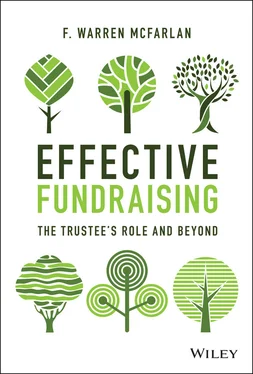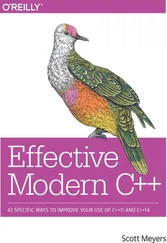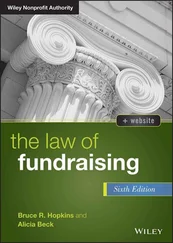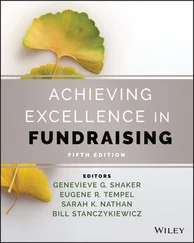1 The definition and approval of the organization's mission and the strategy to achieve it.
2 The selection, coaching, and evaluation of the CEO.
3 The securing of the necessary financial resources for the organization.
This book has focused on the third of these roles—the one that social enterprise CEOs repeatedly say consumes 50% of their time. Without funds, mission cannot be fulfilled. Development is the lifeblood of most social enterprises, be they large or small. It is the unique and special responsibility of its trustees and supporters to help secure resources for the organization. These resources are often critical to the organization's success, if not survival. There are many ways that individual trustees, given their resources and skill sets, can go about this task. Attracting and harnessing the energies of the right people is key to the long-term success of development.
Without a sustainable revenue model, even the most exciting mission-driven organization will collapse. Repeatedly, my social enterprise CEO friends say that over half their lives (and the harder half) are focused on fundraising. The dirty truth is with no fundraising, there is no social enterprise or enduring mission.
This book is focused squarely on that reality: Asking for Money. Many people dislike doing it, seeing it as akin to begging. Others don't do it very well. My view is that everything from governance to specific services is shaped by the need for a sustainable revenue model. You must have the right trustees and other solicitors to make this happen. An organization often does noncore things to raise money to support the essence of an enterprise. That is why the first chapter is on governance. The assembly of askers and connectors in the right numbers and with the right abilities on the board, in the volunteer community, and in senior management, is key. The second chapter is the companion to Chapter 1—namely, the senior management and senior board membership must be revenue/philanthropic oriented to their very core. A church minister, a museum head, a school head, all must be able to create the excitement and ambiance that brings the organization alive and makes people want to contribute financial resources to it. Revenues come in two kinds. The first are fees that can be charged for services or products. Vital to the operation of these organizations, they are not normally sufficient to keep them alive. Rather, there are five major sources of additional revenue that collectively must make up the gap. The first is the annual fund. An annual fund can range from covering 90% of the organization's budget and expenses (a church) to 3% of the budgeted expenses for a large teaching hospital. The second is a capital campaign, targeted at raising money for long-term strategic purposes, which can range from short and modest to large and long. Often a capital campaign provides institutionally transforming gifts. The third source of revenue is planned gifts. Realizable in full on the death of the donor, they often take several decades to materialize. They lay the foundation for infrastructure improvements, financial aid, new programs, and so forth. This is money that you will not get today but will irrevocably get eventually. Fourth are grants secured from foundations. These grants help enable a whole variety of useful projects. Finally, there are galas and all sorts of special fundraising events. These are occasions where people convene to have a good time and also raise funds. University reunions, golf tournaments, and museum black-tie galas are prototypes of these sorts of events.
This book is not devoted to the romance of mission definition and how to shape it. Rather, it is devoted to helping raise the financial resources for these good deeds. It is inelegant and absolutely vital. It puts the burden of social enterprise success on the right shoulders—yours! As a trustee, as a donor, as a connector, or a friend, you are the person most responsible for the success of the social enterprise.
1 1Marc J. Epstein and F. Warren McFarlan, Joining a Nonprofit Board: What You Need to Know (John Wiley & Sons, 2011).
THE MATERIAL IN this book is the outgrowth of field research done over the past two decades at Harvard Business School (HBS), and over 40 years of active social enterprise board service by the author. I am particularly grateful to Dean John McArthur at HBS who inspired me to launch this work. His work at Brigham and Women's Hospital as board chair legitimized this type of work for a generation of HBS faculty. I am also grateful to HBS Deans Kim Clark, Jay Light, and Nitin Nohria who have supported my work in this area over a number of years. I am indebted to all the board members and nonprofit executives I have worked with over the years.
All the examples in the book come from real organizations. They are the results of observations of strategic decisions and actions. Some organizations I am able to publicly thank such as Trinity College, Mount Auburn Hospital, and the Dana Hall School. Others must remain anonymous. A special thanks is due to Professors Kasturi “Kash” Rangan and Herman “Dutch” Leonard, the co-heads of HBS's Social Enterprise Initiative for the past decade, who supported my work enthusiastically. I am also grateful to Eliot Snider, a long-term member of Harvard Business School's Social Enterprise Advisory Board, who particularly focused my attention on philanthropy and how to stimulate it. A special note of thanks goes to my spouse, who supported me through thousands of hours of board meetings; my colleagues Professors Jim Austin, Michael Chu, Mitch Weiss, Allen Grossman, and Alnoor Ebrahim who have been very supportive as has been Matt Segneri and Laura Moon, the last two directors of HBS's Social Enterprise Initiative.
The final responsibility for what appears in this book, of course, is mine. I would also particularly want to thank my administrative assistant Maureen Donovan for the past 40 years for all her valuable administrative support of this work.
OVERWHELMINGLY, WHEN ONE is asked to join the board of a social enterprise, the reaction is one of pleasure and personal pride even if one's other commitments do not allow one to accept. The opportunity to contribute time, energy, and money to an important community or civic enterprise is seen as exciting. Your sense of self-worth is validated by the invitation. Very often, however, one's second comment to the invitation runs along the lines of “I don't have to ask people for money, do I?” Asking for money somehow seems demeaning and distasteful to many individuals. Also the idea of being rejected by a prospective donor is often very personally threatening to one's self-esteem. Even high-powered, otherwise highly self-confident people can turn to jelly when having to ask people for money. A global banker who has put together deals all around the world, described to the author visibly breaking into a cold sweat when forced to solicit other CEOs for seven-figure gifts for charities of mutual interest. He was not used to being a supplicant and did not like it. In his new autobiography What It Takes , 1 Steve Schwarzman, chairman of Blackstone and a billionaire, describes how hard it was for him to first raise funds for Blackstone, and then for the Schwarzman Scholars Program at Tsinghua University in China as he faced rejection after rejection on cold-call solicitations. From top to bottom, there is a common drumbeat of distaste for personal fundraising, which is one of many reasons why professional fundraisers are so well compensated. Yet, without it, otherwise successful organizations can wither and die. In other cases, it is vital to the organization's growth and impact.
Читать дальше












